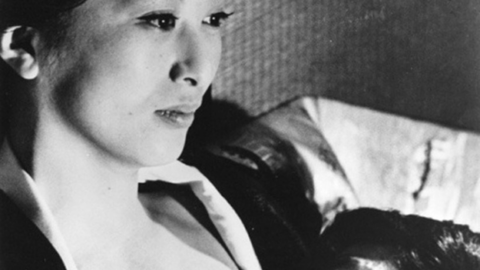By Tony Rayns in the September-October 2008 Issue
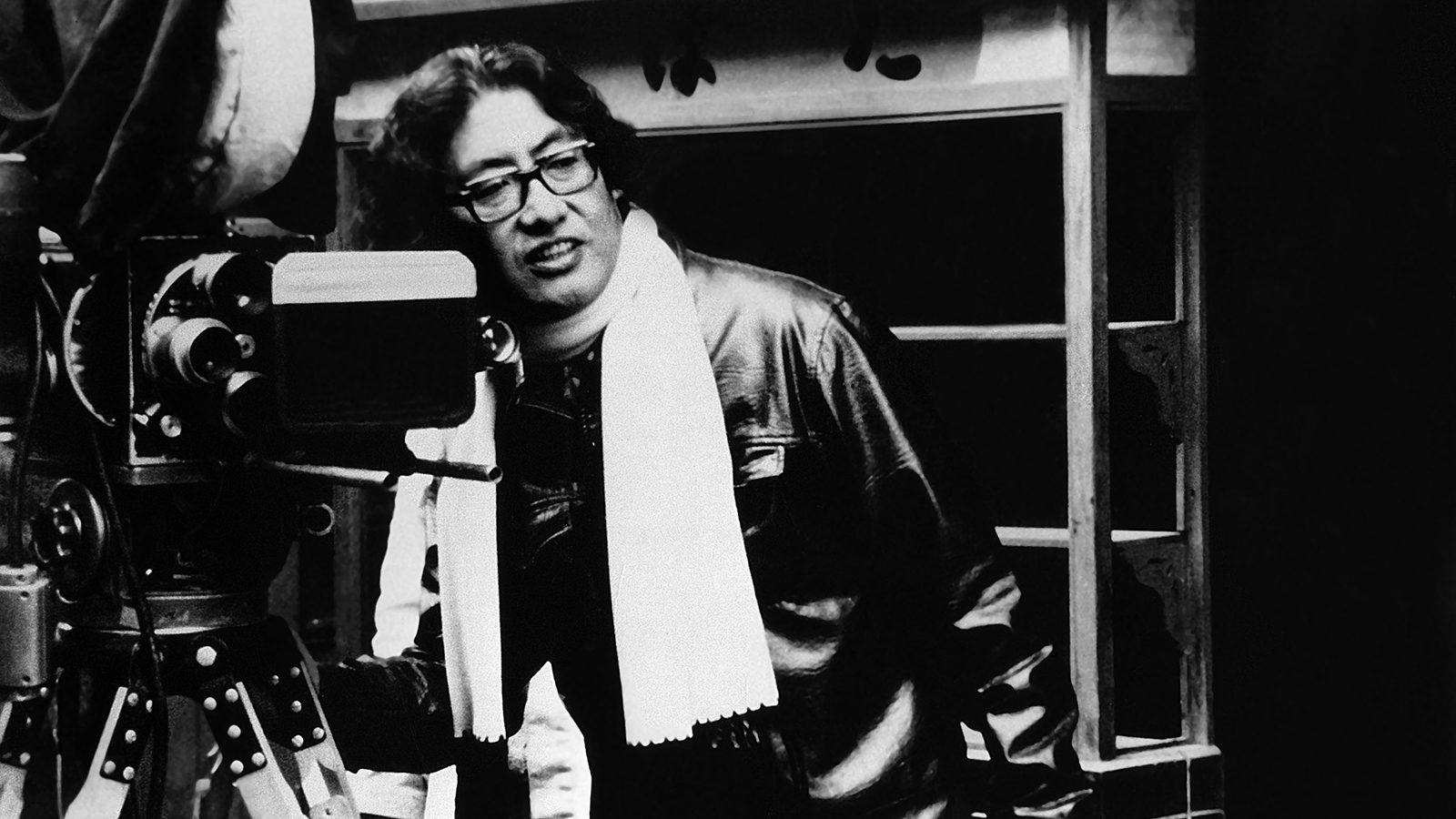
A Samurai Among Farmers
Rejecting the orthodoxies of postwar Japanese society, Nagisa Oshima created a radical and uniquely protean body of work
Forty years ago Nagisa Oshima was one of the biggest names in world cinema, a brilliant modernist who made consistently electrifying films, each one radically different in form and style from the rest. If he’d been French, he’d be as well known as Godard—and probably more influential. Now, confined to his home in the suburbs of Tokyo by the stroke he suffered in 1996 (from which he willed himself into a sufficient recovery in 1999 to make his last film, Gohatto), he’s all but forgotten. One obvious reason is that so little of his work is available on subtitled DVDs, and so the touring retrospective put together by James Quandt at the Cinematheque Ontario is an essential reassertion of his talent and importance.
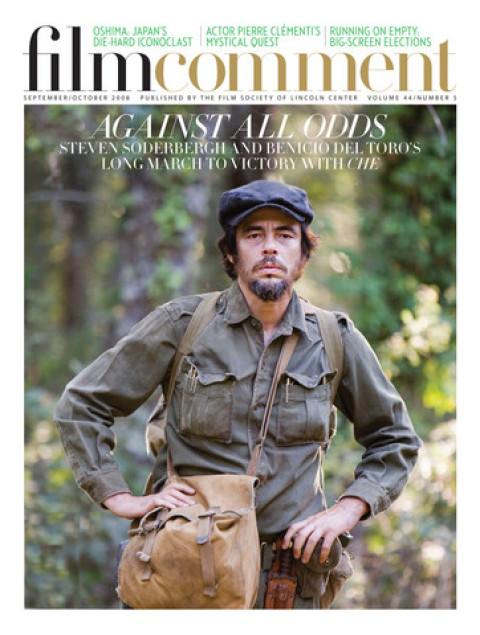
From the September-October 2008 Issue
Also in this issue
Since all too many Film Comment readers have never had access to Oshima’s best work, let’s start with an anecdote. In June 1984, Oshima was in Rome for a retrospective organized by the Marxist critic Lino Miccichè, who had characteristically chosen one of the more difficult films, Night and Fog in Japan (60), for the opening night. The cinema was packed. Gianni Amelio and Bernardo Bertolucci came onstage to welcome the Japanese guest and praise his work, and the screening began.
Few in the room had seen the film before. Set at a wedding party, it dramatizes the bitter conflicts between Japan’s “old” and “new” Left. The immediate issue is the fallout from violent demonstrations against the inevitable renewal of the U.S.-Japan Security Pact, but all kinds of Stalinist purges, factional schisms, betrayals, martyrdoms, and personal jealousies and resentments are given a good airing too. The film’s form is as challenging as its content: shot in color and ’scope and prone to whip-pans, it comprises 43 sequence shots, all of them (including a series of flashbacks) theatrically stylized in ways that Godard didn’t think of until he made Le Gai savoir years later. And the atmosphere is no less clogged and oppressive than the political wrangling: the film opens and closes in highly symbolic thick fog. It’s a tough watch.
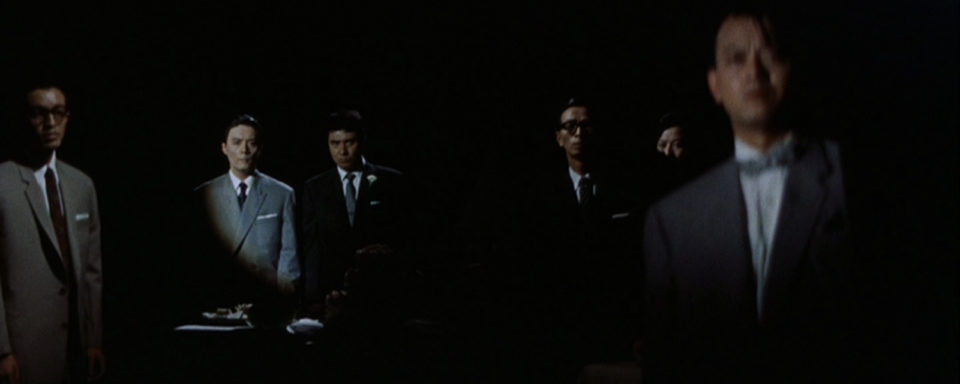
Night and Fog in Japan
Thirty-some minutes into the 107-minute film, there was a commotion in the cinema. Oshima himself was protesting that the reels were in the wrong order, that the projection had to be stopped. It emerged that the print had been “made up” on a giant spool and it would take hours to disassemble and reassemble it; there was no choice but to abandon the screening. And so the audience dispersed and the guests repaired to a nearby hostelry, where Oshima shed his jacket, rolled up his shirtsleeves, drank plenty of wine, and was the life of the party. I have to admit that although the particular form of the film made it hard to be sure, I didn’t think the reels were in the wrong order at all. Donald Richie, also present, wasn’t convinced either. My impression was that Oshima had sensed that the audience was becoming restive and had perhaps unconsciously created an excuse for cutting the screening short.
Night and Fog in Japan had meant the world to Oshima in 1960. He made it against the advice of many of his friends and contemporaries at Shochiku’s Ofuna Studio, and walked out of his contract with Shochiku a few months after the company withdrew the film from its theaters only four days into release. (They said it was politically inflammatory; a socialist leader had just been murdered by a right-wing extremist.) And when he married the actress Akiko Koyama in 1961, he modeled his own wedding reception on the one in the film and used the groom’s speech to lambaste Shochiku executives. But 25 years later, with Merry Christmas, Mr. Lawrence in international distribution, the Left’s failures and hypocrisies in the Fifties must have seemed as remote to Oshima as they did to that audience in Rome. Whatever its political acumen, righteous fury, and aesthetic daring, the film is squarely addressed to the Japanese student-radical audience of 1960. Few in 1984 would have considered its debates relevant to their lives. Political historians aside, anyone who watches Night and Fog in Japan in 2008 does so simply because it’s an Oshima movie: because he’s a fascinating director, and because it’s interesting to see how he broke with the studio system that launched his career.
The episode in Rome illuminates two key aspects of the director, as a Japanese and as what Barack Obama is calling a “world citizen.” Let’s spell them out. Oshima was born (in 1932) into a family with samurai ancestry, and read law and political science at one of Japan’s most prestigious universities. The reality was much less “Ivy League” than it sounds. Oshima had a sickly, deprived childhood, lost his father at the age of six, and was raised by his impoverished mother in Kyoto, a city he grew to hate. (The father was a civil servant working on government fishery projects; he had a covert interest in socialist and communist thought.) He spent his time at Kyoto University not studying but immersed in student theater and political activism, where he suffered a series of tactical defeats. He then drifted into the film industry almost by accident, and earned the chance to direct features at Shochiku relatively quickly by directing an embarrassing promo short about the company’s latest boy and girl starlets.
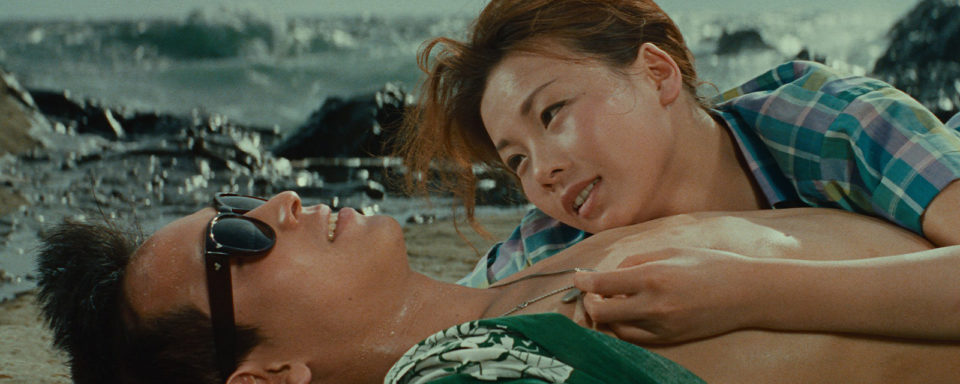
Cruel Story of Youth
That background produced a fundamental ambivalence in Oshima. He sees himself as being in Japan but not of it; he always chooses to distance himself from the national consensus, whatever it is. Donald Richie tells a wonderful story about being on a panel with Oshima in Japan: even when blind drunk, Oshima always remembered to say kono kuni (“this country”) rather than what 99 percent of Japanese would say, waga kuni (“our country”). His independence licenses him to be critical of anyone and anything: the Left, the Right, humanists, communists, film companies, whatever. Oshima spent his most active years as a director compulsively worrying away at specifically Japanese issues: responsibility for the war, racial prejudice against Koreans and other foreigners, colonial attitudes toward Okinawa, and what he identified as the series of political wrong turns in Japan’s postwar history. The films were full-frontally designed to challenge and enrage the Japanese audience. The increasing level of interest he attracted in other countries was a fringe benefit, and had a lot to do with his perceived engagement with the political mood of the late Sixties. It was not until he effectively turned his back in disgust on contemporary culture and politics in the Seventies that he began to think of “remaking” himself as an international filmmaker.
Not surprisingly, his intransigent independence of thought and public criticisms of the mainstream film industry made it increasingly hard for him to raise money, despite an alliance with the tiny Art Theatre Guild (an association of independent cinemas that provided small amounts of money to co-produce “auteur” films and became the default option for many refugees from the studio system), which led to some of his best work in the late Sixties and early Seventies. The first time he found himself unable to raise money, in the early Sixties, Oshima made documentaries for television and took his first trip abroad, to South Korea. The second time, in the early Seventies, he began appearing on television as a news pundit and as the offscreen host of a series of interviews with women about their marital problems, and he started looking further afield for funding to make “international” films. In the Realm of the Senses (76), Empire of Passion (78), Merry Christmas, Mr. Lawrence (83), Max Mon Amour (86), and the television documentaries Kyoto, My Mother’s Place (91) and 100 Years of Japanese Cinema (94) were all financed—and in two cases, shot—outside Japan. Only the post-stroke film Gohatto (99) was fully Japanese.
The visit to Korea was crucial in helping Oshima to formulate his strategies as an independent. By his own account, its effects were lasting: “My trip in 1964 to South Korea, a former colony of Japan, had a great influence on my life and fate,” he was quoted in later promotional materials. Ten years after the Korean War, the south was under an anti-communist military dictatorship (Park Chung-hee had seized power in a coup in 1961) and poverty was widespread. Oshima had nothing to say about Korean politics or government; he merely noted that student protests had overthrown the Syngman Rhee administration in 1960. But he was very struck by the spirit of the people—especially the street boys selling gum and newspapers or shining shoes, who reminded him of the boy in his debut film A Town of Love and Hope and made him think of his own recently born son. What impressed him most was that they refused to beg but insisted on somehow earning a living. Back in Tokyo, inspired by the publication of the supposed diary of one such Korean street boy, Oshima turned his photos from the trip into the 25-minute film Yunbogi’s Diary (65). The soundtrack juxtaposes quotes from the book with an incantatory narration urging Koreans to remember Japanese colonial oppression and Korean street boys to grow up to become student radicals.
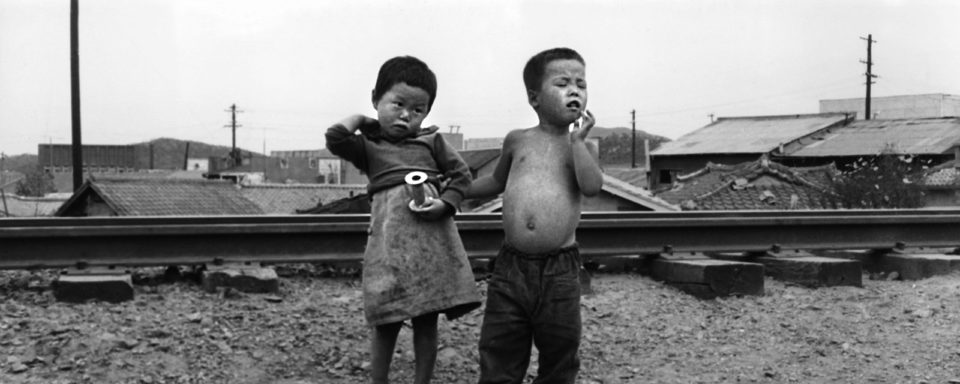
Yunbogi’s Diary
Oshima was still preoccupied by the notion of student-led revolution at the time, and both of the historical pictures he made in the Sixites were intended as lessons for the student movement: The Rebel Amakusa Shiro (62, made as a freelance for the Tohei company) chronicles the defeat of a Christian insurrection in the 17th century, and Band of Ninja (67, shot from the pages of a 16-volume manga by Sanpei Shirato) explores the motivations of rebels resisting Oda Nobunaga’s 16th-century push to unify Japan. But his growing awareness of the situation of Koreans in Japan offered a way out of the impasse of student politics, and led Oshima into a suite of three disparate features.
The semi-improvised A Treatise on Japanese Bawdy Song (67, released on subtitled DVD in Hong Kong under the crass title Sing a Song of Sex) juxtaposes the sexual longings of four male students with an impassioned lecture, delivered by Oshima’s wife, on the Korean origins of the Japanese race itself. The black comedy Death by Hanging (68) reimagines the case of a highly intelligent Korean-Japanese high-school boy who was hanged in 1963 for raping and murdering two young women five years earlier; the film is equally about questions of Korean identity in Japan, thought-crime, and capital punishment. And the anarchic comedy Three Resurrected Drunkards (68) centers on three students who, for complicated reasons, wind up wearing the clothes of some deserters from the Korean army; the deserters are trying to enter Japan illegally to avoid being sent to Vietnam during their compulsory military service. The film includes a vox-pop montage in which all interviewees follow the Spartacus gambit by claiming to be Korean; among them is Oshima himself.
This loose “Korean trilogy” pointed at least three ways forward for Oshima’s filmmaking. First, it liberated him from thinking himself inescapably implicated in the student-radical movement, and from Japan’s “consensus-identity” in general. Identifying himself with the most discriminated-against minority in Japan opened the door to wider perspectives. Second, it ended forever his faith in “realism” as a viable idiom for his work; his subsequent films all interweave “reality” with individual and collective fantasies. (In interviews since 1969, Oshima has more than once named Buñuel as the only director he profoundly admires.) Third, it clinched his growing sense that sex and crime (and, of course, sex crimes) rather than politics were the pressure points that needed his shiatsu touch. Crime is by definition an act of disobedience, and Oshima, like Jean Genet, sees in it the seeds of rebellion. Sex can be defined as a physical act with limitless mental ramifications; the Japanese (who had no Puritan tradition until General MacArthur imported one in 1945) are generally more matter-of-fact about sex than most western countries, but no less prone to transgressive libidinal impulses—and it’s the transgression, of course, that Oshima sees as potentially rebellious.
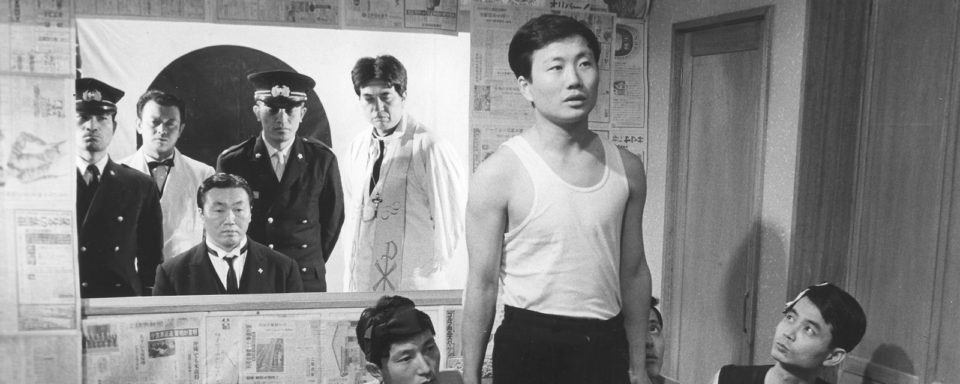
Death by Hanging
Oshima’s most suggestive account of crime is probably Boy (69), in which two banally evil parents force their young son to fake traffic accidents so that they can scam the motorists for payoffs. There’s a toss-up between two films for the tingliest chronicle of sexual desires: it’s either Diary of a Shinjuku Thief (68), straight but with a girlish boy and a boyish girl, or Gohatto (99), gay.
But there’s no doubt that his most incandescent treatments of sex crimes are found in the diptych he made for the French producer Anatole Dauman. In the Realm of the Senses (Ai no Corrida, 76) is his version of No Exit, a fatal, erotic reverie about two lovers who retreat into a private world defined and fueled by their own sexual fantasies and nothing else. It’s based on actual events that transpired in 1936, and Oshima respects the period setting, mindful that it was the year of an attempted military coup to restore Imperial rule. But the fantasy has an implacable logic all its own: the lovers create a world in which the man passively submits to death to heighten his and the woman’s pleasure, and in which his phallus remains erect even when it’s severed from his lifeless body. Typically for Oshima, Empire of Passion (Ai no Borei, 78) is the exact converse: a story of illicit lovers consumed by guilt, set in a social context and a natural rather than artificial environment, highlighting concealment rather than exposure. The voyeurs in In the Realm of the Senses are all women, but the thwarted voyeur in Empire of Passion is male, a bumbling cop. (Bumbling cops, incidentally, are recurrent figures in Oshima’s movies. He once told me that he didn’t set out to make this one comic: “I made him ridiculous, because I think in the end it’s more frightening that way.”)
Some have seen the lavender-suited, dandyish Oshima of the Eighties as compromised: a lapsed leftie, sold out to television and showbiz. It’s true that he did appear in a TV ad for a roach-killing spray, dressed as a schoolboy lepidopterist, but he did it for the money; like all other independent filmmakers, he had cash-flow problems. His unabated anger over the state of leftist politics had been a matter of public record at least since Night and Fog in Japan. And his flirtations with “showbiz” stretched back two decades anyway and were equally hard-nosed—they were strategies to help draw attention to challenging movies that were given, at best, marginal distribution. Hence the casting of singer and gossip-column fixture Ichiro Araki in A Treatise on Japanese Bawdy Song. Casting showbiz celebrities in unexpected roles became a staple Oshima strategy. Kazuhiko Kato, founder-leader of the Sadistic Mika Band, starred in Three Resurrected Drunkards; Tadanori Yokoo, then Japan’s hippest designer, starred in Diary of a Shinjuku Thief; and comedian “Beat” Takeshi was given his first serious acting role in Merry Christmas, Mr. Lawrence, alongside David Bowie and Ryuichi Sakamoto.
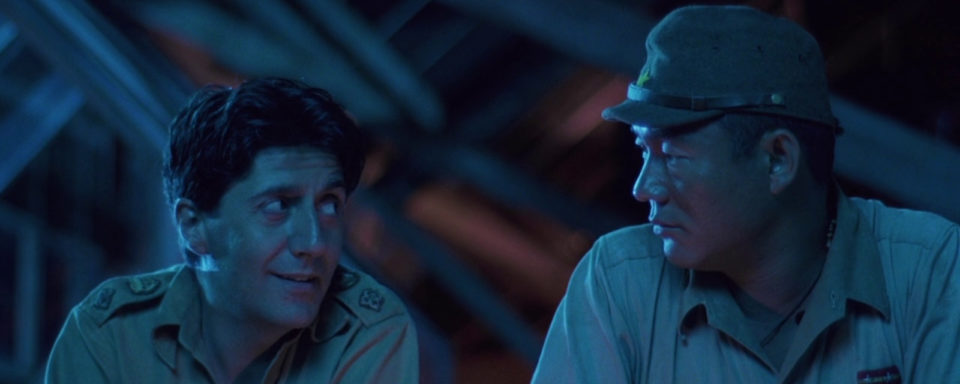
Merry Christmas, Mr. Lawrence
Given that he was never a “movie brat,” Oshima proved remarkably inventive in both his choices of subject and his approach to film language right from the start. His early Shochiku features have a distanced, analytical side that sometimes trumps their aggressive nihilism: the B-movie A Town of Love and Hope (59) offers a bitter story of irreconcilable class difference but expertly pastiches the studio’s homely house-style to tell it, and The Sun’s Burial (60) frames its lurid exposé of feral life in the Osaka slums within smart intellectual metaphors, such as an economy based on the “circulation” (i.e., buying and selling) of blood. (Such strategies put some space between Oshima and his young contemporaries at Shochiku, who were content to give genre movies a few “personal” inflections—which helps to explain why he was angrily dismissive when Japanese critics began bandying about the term “Japanese New Wave.”) The later films made for his own independent companies are not just varied in tone and style but absolutely committed to nonstop change. From film to film he shuttles between monochrome and color, between Academy ratio and ’scope, between static, formal compositions and the ramshackle look of home movies, between extended takes and fragmented cutting.
It wasn’t hard for Oshima to establish himself as an important voice in Japanese culture in the Sixties because there were so few other iconoclasts around; in the counterculture, only playwright/underground filmmaker Shuji Terayama came close. But did that high personal profile explain his refusal to develop a recognizable personal style? Was he simply breaking with the studio-system “masters” whose work was so consistent, or did the sheer variety of his output represent another facet of his iconoclasm?
Actually, Oshima never made things easy either for himself or his audience. He approached each project as a specific emotional and intellectual challenge, requiring its own dynamics and idiom, and assumed that viewers would find the films interesting enough to be willing to put in the effort to keep up. This was already true in the disturbing Violence at Noon (66), in which a serial killer of women becomes a cipher for the collapse of postwar idealism and in which constant reframing fragments the smallest action into a kind of visual stutter that’s deliberately disorienting. By the time he comes to The Man Who Left His Will on Film (70), Oshima is questioning the act of filmmaking itself; a student-radical film group that has lost faith in the very notion of “political cinema” struggles to find meaning in seemingly random images of city streets. Conversely, in The Ceremony (71), Oshima re-embraces allegorical representation by rhyming the ruinous history of one extended family with the shifts and turns of postwar politics and with his own wry reflections on sexual and political inadequacy. Like Night and Fog in Japan, such films are as conceptually demanding now as they ever were.
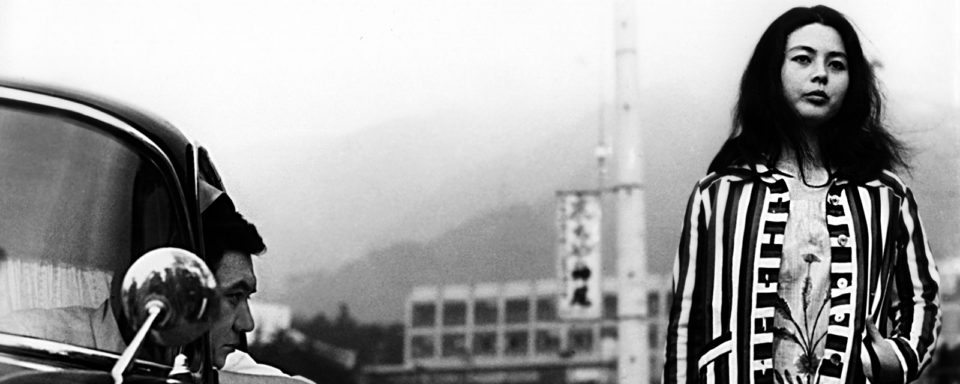
Violence at Noon
The final complication is Oshima’s always latent playfulness. When, for instance, the protagonists of Three Resurrected Drunkards are killed off by the Korean army deserters about halfway through the film, Oshima simply starts the film again and takes it to a different conclusion. Audiences, he noted with delight, thought that the wrong reel had been put on.
“I’m a country farmer; Nagisa Oshima is a samurai.”
—Shohei Imamura



